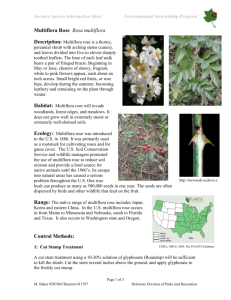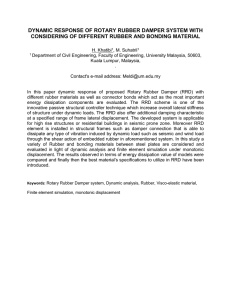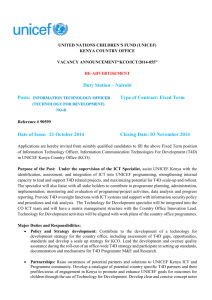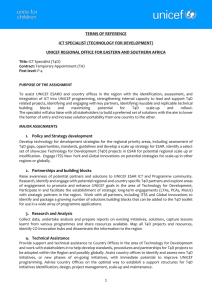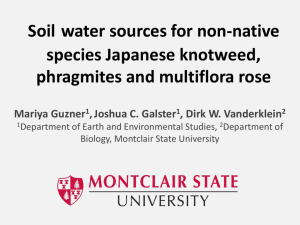Abundance of arthropods on the branch tips of the Rosa multiflora
advertisement
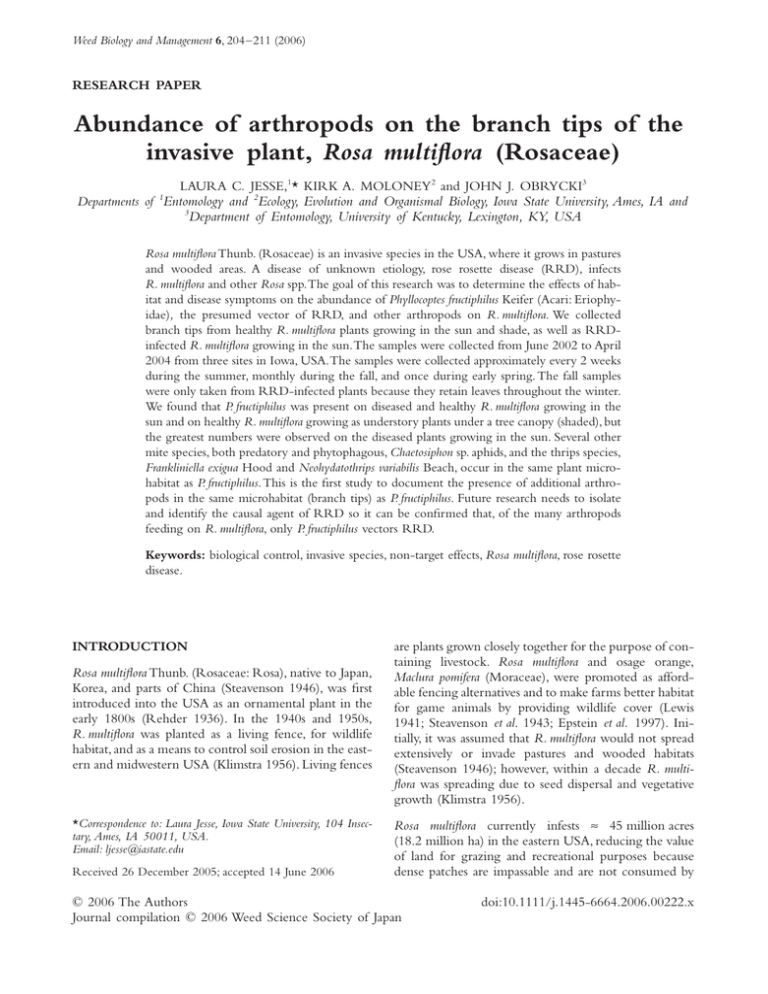
Blackwell Publishing AsiaMelbourne, AustraliaWBMWeed Biology and Management1444-61622006 Weed Science Society of JapanDecember 200664204211Original ArticleArthropods on Rosa multiflora branch tipsL. C. Jesse et al. Weed Biology and Management 6, 204–211 (2006) RESEARCH PAPER Abundance of arthropods on the branch tips of the invasive plant, Rosa multiflora (Rosaceae) LAURA C. JESSE,1* KIRK A. MOLONEY2 and JOHN J. OBRYCKI3 Departments of Entomology and 2Ecology, Evolution and Organismal Biology, Iowa State University, Ames, IA and 3 Department of Entomology, University of Kentucky, Lexington, KY, USA 1 Rosa multiflora Thunb. (Rosaceae) is an invasive species in the USA, where it grows in pastures and wooded areas. A disease of unknown etiology, rose rosette disease (RRD), infects R. multiflora and other Rosa spp. The goal of this research was to determine the effects of habitat and disease symptoms on the abundance of Phyllocoptes fructiphilus Keifer (Acari: Eriophyidae), the presumed vector of RRD, and other arthropods on R. multiflora. We collected branch tips from healthy R. multiflora plants growing in the sun and shade, as well as RRDinfected R. multiflora growing in the sun. The samples were collected from June 2002 to April 2004 from three sites in Iowa, USA. The samples were collected approximately every 2 weeks during the summer, monthly during the fall, and once during early spring. The fall samples were only taken from RRD-infected plants because they retain leaves throughout the winter. We found that P. fructiphilus was present on diseased and healthy R. multiflora growing in the sun and on healthy R. multiflora growing as understory plants under a tree canopy (shaded), but the greatest numbers were observed on the diseased plants growing in the sun. Several other mite species, both predatory and phytophagous, Chaetosiphon sp. aphids, and the thrips species, Frankliniella exigua Hood and Neohydatothrips variabilis Beach, occur in the same plant microhabitat as P. fructiphilus. This is the first study to document the presence of additional arthropods in the same microhabitat (branch tips) as P. fructiphilus. Future research needs to isolate and identify the causal agent of RRD so it can be confirmed that, of the many arthropods feeding on R. multiflora, only P. fructiphilus vectors RRD. Keywords: biological control, invasive species, non-target effects, Rosa multiflora, rose rosette disease. INTRODUCTION Rosa multiflora Thunb. (Rosaceae: Rosa), native to Japan, Korea, and parts of China (Steavenson 1946), was first introduced into the USA as an ornamental plant in the early 1800s (Rehder 1936). In the 1940s and 1950s, R. multiflora was planted as a living fence, for wildlife habitat, and as a means to control soil erosion in the eastern and midwestern USA (Klimstra 1956). Living fences *Correspondence to: Laura Jesse, Iowa State University, 104 Insectary, Ames, IA 50011, USA. Email: ljesse@iastate.edu Received 26 December 2005; accepted 14 June 2006 are plants grown closely together for the purpose of containing livestock. Rosa multiflora and osage orange, Maclura pomifera (Moraceae), were promoted as affordable fencing alternatives and to make farms better habitat for game animals by providing wildlife cover (Lewis 1941; Steavenson et al. 1943; Epstein et al. 1997). Initially, it was assumed that R. multiflora would not spread extensively or invade pastures and wooded habitats (Steavenson 1946); however, within a decade R. multiflora was spreading due to seed dispersal and vegetative growth (Klimstra 1956). Rosa multiflora currently infests ≈ 45 million acres (18.2 million ha) in the eastern USA, reducing the value of land for grazing and recreational purposes because dense patches are impassable and are not consumed by © 2006 The Authors Journal compilation © 2006 Weed Science Society of Japan doi:10.1111/j.1445-6664.2006.00222.x Arthropods on Rosa multiflora branch tips most livestock (except goats) (Loux et al. 2005). Rosa multiflora has been declared a noxious weed in nine states, including Iowa (Amrine & Stasny 1993). Infestations are most common in pastures and in nearby forested areas, similar to areas where it was intentionally planted (Steavenson et al. 1943; Steavenson 1946; Burgess 1948; Epstein et al. 1997). As a result of a large seed bank, any reduction of R. multiflora must include long-term management plans to destroy new seedlings as they appear (Loux et al. 2005). Currently, mechanical and herbicidal control methods are most commonly used to suppress R. multiflora (Loux et al. 2005). These methods are expensive, time-consuming, often ineffective, and have negative environmental effects, including the destruction of nontarget vegetation (Loux et al. 2005). Biological control might offer a long-term, viable solution to R. multiflora management: one macro-organism and one disease have been identified as having the potential to provide biological suppression of R. multiflora. The first is Megastigmus aculeatus (Hymenoptera; Torymidae), whose larvae feed in R. multiflora seeds (Balduf 1959). The second is rose rosette disease (RRD), a disease with unknown etiology and uncertain classification, which reduces plant vigor and eventually kills R. multiflora. Despite extensive study, the causative agent of RRD has not been identified (Epstein & Hill 1999). The symptoms of RRD (witches broom or mosaic discoloration) were first reported in an unidentified rose species in Manitoba, Canada, in 1940 and 1941 (Conners 1941, 1942). It was reported in the USA in 1941, in Wyoming, from an ornamental rose, Rosa rubriflora; an unidentified native rose species also was noted to have symptoms of RRD in the same area in 1942 (Thomas & Scott 1953). Based on the disease symptoms and the ability to infect healthy plants by grafting, the causal agent of RRD was believed to be a virus (Thomas & Scott 1953). Additionally, the symptoms are observed when diseased plants are treated with the antibiotic, tetracycline, which kills bacterial pathogens. Evidence also suggests that the agent is not a phytoplasma because tests using polymerase chain reactions with primers known to detect phytoplasma failed to detect this type of pathogen (Epstein & Hill 1999). Thus, the causal agent, which is not identified, is presumed to be a virus. Rose rosette disease is presumed to be spread by an eriophyid mite, Phyllocoptes fructiphilus (Acari: Eriophyidae) (Allington et al. 1968; Amrine et al. 1988); however, Doudrick et al. (1986) could not demonstrate the transmission of RRD to R. multiflora by P. fructiphilus in 205 greenhouse trials. Doudrick et al. (1986) stated that the inability to establish colonies of P. fructiphilus on R. multiflora is the reason they failed to observe mite transmission of RRD. On the basis of the studies conducted by Allington et al. (1968) and Amrine et al. (1988), it is generally accepted that P. fructiphilus is the only vector of RRD. However, only P. fructiphilus and Tetranychus urticae, the two-spotted spider mite, have been studied as possible vectors (Amrine et al. 1988). Phyllocoptes fructiphilus has a four-stage eriophyid mite life cycle: egg, protonymph, deutonymph, and adult (Kassar & Amrine 1990). In a 4 year study conducted in Indiana, Amrine (1996) observed higher mite populations on R. multiflora with RRD compared to mite populations on healthy R. multiflora (Amrine 1996). Kassar and Amrine (1990) found P. fructiphilus wintered on R. multiflora singly and in groups under bud scales and loose bark in the previous year’s growth. Previous researchers have noted an apparently lower incidence of RRD in multiflora rose plants growing in shaded areas as an understory plant under a tree canopy (Epstein & Hill 1995). However, the effect of habitat on populations of P. fructiphilus has not been examined previously. It is unknown whether this is related to physiological differences in the plants (e.g. effects of lower light intensity on plant growth, which might influence the disease) or if the mite prefers more open, sunny locations (e.g. related to differences in mite dispersal behaviors). If differences are observed in relation to P. fructiphilus occurrence on R. multiflora plants growing in open canopy (sunny habitats), in comparison to plants growing in the understory (shaded habitats), this might indicate that RRD is not an effective mortality factor of plants in the shady habitats if RRD is only vectored by P. fructiphilus. Many R. multiflora-infested pastures are adjacent to wooded areas that also contain multiflora rose. Rosa multiflora plants in these wooded areas might remain unaffected by RRD and serve as a seed source to reinfest pastures. The objectives of this study were to: (i) document the effects of the R. multiflora habitat (open vs closed canopy) on P. fructiphilus; (ii) examine the effects of RRD symptoms on the abundance of P. fructiphilus on R. multiflora growing in open habitats; and (iii) quantify the abundance of selected phytophagous arthropods (aphids, thrips, and additional mite species) found on the growing tips of R. multiflora branches, the same microhabitat used by P. fructiphilus, because these other arthropods are potential disease vectors. © 2006 The Authors Journal compilation © 2006 Weed Science Society of Japan 206 L. C. Jesse et al. MATERIALS AND METHODS Two sites were located in Story County Conservation Board parks in central Iowa (Christiansen Forest Preserve [41°54′Ν, 93°34′W] and Dakins Lake [42°10′N, 98°34′W]) and one site was located in an infested pasture in Boone County, Iowa (42°06′N, 93°56′W). Samples were collected from June 2002 to April 2004 from the two sites in Story County and from November 2002 to April 2004 at the Boone County site. The samples were collected approximately every 2 weeks during the summer, monthly during the fall, and once during early spring.The fall samples were only taken from the RRDinfected plants which, unlike the unsymptomatic plants, retain leaves throughout the winter. On each sampling date, 20 branch tips (≈ 6 cm) were cut from each of three R. multiflora plants in open areas (no trees within 5 m) and three plants growing as understory plants (shaded) with no visible symptoms of RRD, and from three R. multiflora roses also growing in open areas, with symptoms of RRD.The 20 branch tips were placed in plastic sandwich-type bags with a zip seal to prevent the arthropods from moving off the branches. No plants growing in the understory with symptoms of RRD were observed at these three sites so we could not sample RRD-symptomatic plants growing in the shade as an understory plant. At the sites in Story County, 42 samples were collected from R. multiflora in both sunny and shady sites and 57 samples were taken from plants with RRD. At the Boone County site, R. multiflora plants growing in the shade or sun were sampled 24 times and RRD plants were sampled 39 times. As a result of the relatively low number of plants in some habitats, the same plant was often sampled multiple times. A wash solution of tap water, 0.2% dish soap, and 2% sodium hypochlorite was used to remove the arthropods from the foliage (de Lillo 2001).The 20 branch tips from a single R. multiflora were weighed and then placed together in a 400 or 1000 mL glass beaker. The leaves were removed and counted from each stem to expose any arthropods in the basal attachment sites of the leaves. The bags which held the branch tips were rinsed with the washing solution, the contents were poured into the beaker, and additional washing solution was added until the leaf tissue was fully covered. A magnetic stirring bar (Fisher Scientific, Pittsburg, PA, USA) was placed in the beaker and the plant material and washing solution was stirred for 5–10 min at room temperature (de Lillo 2001). The solution was filtered through four stainless steel sieves stacked by descending mesh size; 850 µm, 180 µm, 53 µm, and 25 µm (Topac, Hingham, MA, USA). The plant material was rinsed in tap water in the 850 mm sieve to dislodge mites and other arthropods (de Lillo 2001). Phyllocoptes fructiphilus range in size from 168–204 mm long and 50–60 µm wide, and so the 180, 53, and 25 mm screens were examined for mites and other arthropods. A wash bottle filled with the wash solution was used to rinse the screen contents into an 8.5 cm diameter (56.7 cm2) Petri dish. One to two drops of dish soap were added to the Petri dish and mixed by carefully moving the Petri dish back and forth (de Lillo 2001). The Petri dish was allowed to sit for at least 1 min so the mites settled to the bottom, then the mites were counted under a dissecting microscope (Olympus SZH; Leeds Precision Instruments, Minneapolis, MN, USA). Subsampling of the 53 and 25 mm screen contents was used to estimate the arthropod numbers. A subsample consisted of counting the arthropods in 0.5 cm × 0.5 cm squares arranged in a figure “8” shape across the Petri dish; 38 squares were examined for a total of 9.5 cm2. Only P. fructiphilus mites were observed in the 25 mm Petri dish. If there were fewer than 10 P. fructiphilus in the 53 mm dish, the 25 mm dish was not counted. Selected arthropods were sent to the United States Department of Agriculture Systematic Entomology Laboratory, Beltsville, MD, USA, for identification. Voucher specimens are deposited in the Iowa State University Entomology Department Insect Museum. The arthropod abundance data were summarized per weight (gram) of the 20 branch tips collected from each plant. The data were log-transformed prior to statistical analysis, so the median values are presented. Analysis of variance was used to analyze site (three sites), habitat (sun, shade, RRD plants in the sun), and site by habitat effects. Within an effect, the least squares means were compared with the Tukey test (SAS 9.1 for Windows; SAS Institute, Cary, NC, USA). RESULTS Plants with the symptoms of RRD had the most leaves (Fig. 1), which was expected because one of the symptoms of RRD is increased leaf production. However, we observed no correlation between the number of leaves and the number of P. fructiphilus (linear R2 = 0.0004). We observed aphids, thrips, eriophyid mites, and other mite species on healthy and diseased R. multiflora growing in the sun and on healthy R. multiflora growing in shaded habitats (Fig. 2). The most commonly observed arthropods were eriophyid mites on RRD-symptomatic plants. The median number of eriophyid mites found on R. multiflora was different depending on the habitat the plant was growing in (sun or shade) and whether or not © 2006 The Authors Journal compilation © 2006 Weed Science Society of Japan 160 (a) 140 300 Average arthropods g–1 Average number of leaves Arthropods on Rosa multiflora branch tips 120 100 80 60 40 250 200 150 100 50 20 0 207 0 Shade Sun Sun + RRD Shade Sun Location of plant Aphids Fig. 1. Average number of leaves (±SE) on 20 Rosa multiflora branch tip samples over a 2 year period in three field sites. RRD, rose rosette disease. Non-eriophyid mites found in the R. multiflora samples included predatory mites, fungivorous mites, and phytophagous mites (Table 1). The non-eriophyid mite species were most abundant during the summer. More non-eriophyid mites were found on R. multiflora growing in the shade (P < 0.0001). In the sunny habitat, similar numbers of mites were observed on RRDsymptomatic plants and apparently healthy plants (P = 0.7).The number of mites at the three field sites was also significantly different (P = 0.0006), with Dakins having the most and Boone having the fewest mites. The thrips species observed on R. multiflora included Frankliniella exigua Hood and Neohydatothrips variabilis Beach (Table 1). The highest number of thrips was Sun Sun & Shade RRD Eriophyid mites Sun Sun & Shade RRD Other mites Sun Sun & RRD Thrips (b) Average arthropods g–1 700 600 500 400 300 200 100 0 Shade Sun Aphids Sun & Shade RRD Sun Sun & Shade RRD Eriophyid mites Sun Sun & Shade RRD Other mites Sun Sun & RRD Thrips (c) 500 Average arthropods g–1 the plant was diseased (Fig. 3) (P < 0.006). The greatest number of eriophyid mites was found on the plants showing symptoms of RRD (P < 0.0001) and plants in the sun had more eriophyid mites than plants growing in the shade (P = 0.006). At the three sites, the number of mites tended to be highest during the summer months, although eriophyid mites were present on the RRD plants on all sampling dates. There were significant differences among the number of eriophyid mites at the three field sites (P < 0.0001). The number of mites at Dakins and Christiansen was similar (P = 0.34), but Boone was different from both Dakins and Christiansen (P < 0.0001). This is probably related to the different sampling times; Boone was not sampled during the summer of 2002. Even though the sampling times differed, the number at the Boone site was generally lower. Most of the eriophyid mites were identified as P. fructiphilus; however, two mites from Dakins were identified as Phyllocoptes adalius Keifer (Table 1). Phyllocoptes adalius is not known to be a vector of RRD (Amrine et al. 1994). Sun & Shade RRD 450 400 350 300 250 200 150 100 50 0 Shade Sun Aphids Sun & Shade RRD Sun Sun & Shade RRD Eriophyid mites Sun Sun & Shade RRD Other mites Sun Sun & RRD Thrips Insects Fig. 2. Average number of arthropods per gram (±SE) on the branch tips from three healthy Rosa multiflora plants growing in the shade and in the sun, and from three R. multiflora plants exhibiting symptoms of rose rosette disease (RRD) at three locations in central Iowa: (a) Christiansen Park, Story County, (b) Dakins Park, Story County and (c) Boone County. observed at Dakins Park (P < 0.0001). Christiansen Park and the Boone site had similar numbers of thrips (P = 0.7). The habitat (shady or sunny) of the R. multiflora and the disease status did not have an effect on the number of thrips present (P = 0.08). © 2006 The Authors Journal compilation © 2006 Weed Science Society of Japan L. C. Jesse et al. 208 (a) Average no. of Eriophyidae 18 000 16 000 14 000 12 000 10000 8000 6000 4000 2000 9/17/2003 10/17/2003 11/17/2003 12/17/2003 1/17/2004 2/17/2004 3/17/2004 4/17/2004 9/13/2003 11/13/2003 12/13/2003 1/13/2004 2/13/2004 3/13/2004 4/13/2004 8/17/2003 8/13/2003 10/13/2003 7/17/2003 7/13/2003 5/17/2003 6/17/2003 4/17/2003 3/17/2003 2/17/2003 1/17/2003 12/17/2002 11/17/2002 10/17/2002 8/17/2002 9/17/2002 7/17/2002 6/17/2002 0 Date (b) Average no. of Eriophyidae 18 000 16 000 14 000 12 000 10 000 8000 6000 4000 2000 6/13/2003 5/13/2003 4/13/2003 3/13/2003 2/13/2003 1/13/2003 12/13/2002 11/13/2002 10/13/2002 8/13/2002 9/13/2002 7/13/2002 6/13/2002 0 Date (c) Average no. of Eriophyidae 18 000 16 000 14 000 12 000 10000 8000 6000 4000 2000 Date The aphids identified from R. multiflora were all Chaetosiphon spp. (Table 1). The aphids were abundant during the summer at the three field sites. There was a significant difference in the numbers of aphids at the three field 4/22/2004 3/22/2004 2/22/2004 1/22/2004 12/22/2003 11/22/2003 10/22/2003 9/22/2003 8/22/2003 7/22/2003 6/22/2003 5/22/2003 4/22/2003 3/22/2003 2/22/2003 1/22/2003 12/22/2002 11/22/2002 0 Fig. 3. Average number of eriophyid mites per gram over time on the branch tips from three healthy Rosa multiflora plants growing in the shade and in the sun, and from three R. multiflora plants exhibiting symptoms of rose rosette disease (RRD) at three locations in central Iowa: (a) Christiansen Park, Story County, (b) Dakins Park, Story County and (c) Boone County. (), sun; (), sun and RRD; (), shade. sites (P = 0.01), with the highest number at Boone and the lowest number at Christiansen Park. There also was a significant difference in the number of aphids in each habitat (P = 0.048). Rosa multiflora with RRD had the © 2006 The Authors Journal compilation © 2006 Weed Science Society of Japan Arthropods on Rosa multiflora branch tips 209 Table 1. Identification of selected arthropods on the branch tips of Rosa multiflora that mite populations on symptomatic R. multiflora were 14-fold higher than those on unsymptomatic plants. Taxa The lowest number of P. fructiphilus was observed on the R. multiflora growing in the shade as understory plants. Epstein and Hill (1995) found a lower number of RRDsymptomatic R. multiflora in shaded areas and a slower increase of disease incidence over a 6 year period in shaded areas compared to plants growing in full sun. They hypothesized that this could be related to lower ambient air temperature affecting the mites or some other unknown factor that reduced the mites’ capacity to vector RRD.We confirmed that there are fewer P. fructiphilus on plants growing in full shade, but we hypothesize this could be a result of the absence of RRD, not the cause. Plants showing symptoms associated with RRD often have greatly increased density of leaf growth, thus providing many more leaf axil microhabitats for P. fructiphilus mite populations. This interpretation is consistent with the observation that there are fewer P. fructiphilus on plants in the sun with no symptoms of RRD. Arachnida Acari† Eriophyidae Phyllocoptes fructiphilus Keifer Phyllocoptes adalius Keifer Phytoseiidae Neoseiulus spp. Phytoseius spp. Stigmaeidae Cheylostigmaeus spp. Tarsonemidae Tarsonemus waitei Banks Tetranychidae Panonychus ulmi Koch Tetranychus spp. Tydeidae Pronematus spp. Tydeus spp. Insecta Hemiptera‡ Aphididae Chaetosiphon spp. Thysanoptera§ Thripidae Frankliniella exigua Hood Neohydatothrips variabilis Beach Number of individuals identified 15 2 1 1 3 1 1 4 Use of Phyllocoptes fructiphilus as a disease vector 3 4 20 3 5 † Identified by Ronald Ochoa, USDA-SEL, Beltsville, MD, USA; ‡ identified by Gary L. Miller, USDA-SEL; § identified by Sueo Nakahara, USDA-SEL. most aphids, whereas healthy R. multiflora (growing in the sun or shade) had similar numbers of aphids. DISCUSSION This study is the first to document the presence of other possible arthropod vectors on R. multiflora with RRD, as well as evaluating the effects of habitat on populations of P. fructiphilus. Phyllocoptes fructiphilus populations were highest on the R. multiflora with RRD symptoms. These results are similar to those reported by Epstein and Hill (1999), who observed much higher numbers of mites on symptomatic R. multiflora compared to unsymptomatic plants sampled from May to September from 1990 to 1992 at two sites in Iowa. Amrine (1996) also reported Rose rosette disease has the potential to be an important tool in managing R. multiflora. Epstein et al. (1997) demonstrated RRD will readily spread to healthy plants in plots where RRD is augmented. Rose rosette disease reduces the flowering and seed set of infected plants and results in the death of the plant within ≈ 5 years (Epstein et al. 1993). As the presumed vector of RRD, it is important to understand the occurrence of P. fructiphilus on R. multiflora. The augmentation of the disease can be successfully accomplished by grafting buds from diseased plants onto healthy plants (Epstein 1995); however, this process is too labor-intensive to be used in heavily infested areas. As an alternative, land managers cut the branches of diseased plants and place them on healthy plants with the expectation that P. fructiphilus present on the branches will move onto the healthy plants. There is no evidence that the mites will move onto the healthy plants, but this study clearly shows that higher mite populations are consistently found on R. multiflora with the symptoms of RRD. There are two major concerns in the manipulation of P. fructiphilus and RRD for the biological control of R. multiflora. The first is that ornamental roses are susceptible to RRD, particularly hybrid tea roses (Epstein & Hill 1999). Although the movement of the mite onto ornamental roses, causing infection, appears to be limited, the risk of RRD is a concern to rose-growers and the rose industry (Dettmann & Pagliai 1993; Harwood 1994). Unfortunately, because RRD naturally occurs in © 2006 The Authors Journal compilation © 2006 Weed Science Society of Japan 210 L. C. Jesse et al. R. multiflora populations, there will always be a source of inoculum with or without augmentation. A better understanding of the temporal and spatial dynamics of mite populations throughout the year will help determine the ways to limit the potential spread of RRD from multiflora rose to ornamental roses. The second problem with the augmentation of RRD is that the causative agent of RRD has not been isolated and identified (Di et al. 1990; Epstein & Hill 1999; Rohozinski et al. 2001). Many attempts have been made to isolate the causal agent, but none have been successful (Rohozinski et al. 2001). Di et al. (1990) found doublestranded RNA associated with diseased tissue, indicating the causal agent could be a cryptic virus. Rohozinski et al. (2001) successfully transmitted a virus-like agent from R. multiflora to Nicotiana spp., but observed no virus-like particles. Arthropod transmission studies of RRD have only been conducted with P. fructiphilus and T. urticae, the twospotted spider mite, primarily because T. urticae commonly infests greenhouse-grown R. multiflora used in experiments. Tetranychus urticae was not observed to transmit RRD (Amrine et al. 1988). Our current study documented that other known vectors of plant pathogens commonly occur on R. multiflora. Aphids, thrips, and some mites are known vectors of plant viruses (Maramorosch 1963), but it is unknown if they are involved in the transmission of RRD. Chaetosiphon spp. aphids were common on the R. multiflora and this genus transmits plant viruses. For example, Chaetosiphon fragaefoili (Cockerell), the strawberry aphid, and Chaetosiphon jacobi both transmit strawberry viruses (Frazier 1968; Krczal 1979). One of the thrips species (Frankliniella sp.) observed on R. multiflora is from a genus known to transmit plant tospoviruses (Maramorosch 1963). If these arthropods transmit RRD, they could spread the disease among R. multiflora plants and also to non-target ornamental roses. Future research needs to isolate and identify the causal agent of RRD so it can be confirmed that, of the many arthropods feeding on R. multiflora, only P. fructiphilus vectors RRD. Until this is done, it is impossible to confirm that large-scale augmentation of RRD to control R. multiflora can be implemented without increasing non-target RRD infections. Use of eriophyid mites in weed biological control Phytophagous mites are good candidates for successful weed biological control programs because of their lim- ited host range; it is estimated that 80% of eriophyids are monophagous (Briese & Cullen 2001). In addition, mites have a high rate of population increase and often have good dispersal ability. Eriophyid mites have been used in biological control programs against invasive weeds, including St John’s wort, rush skeletonweed, and field bindweed (Briese & Cullen 2001). Many eriophyids cause galling in plants, altering resource allocation and reducing plant vigor. Non-gall forming eriophyids also affect plant growth. For example, Aculus hyperici, feeding in the growing tips of St John’s wort, causes a decrease in leaf size and shortening of the internodal distances (Briese & Cullen 2001). Currently, P. fructiphilus is the only eriophyid mite that is being considered for use as a disease vector in biological control (Briese & Cullen 2001). ACKNOWLEDGMENTS We would like to thank the Story County Conservation Board for letting us conduct this survey in their parks and Norma Neyva-Estrada, Statistics Department, Iowa State University, for assistance with statistical analysis, and the USDA-SEL, Beltsville, MD, USA, for the identification of our arthropods. This research was partially funded by a grant from the College of Agriculture at Iowa State University.This is a Journal Paper of the Iowa Agriculture and Home Economics Experiment Station, Ames, Iowa, Project No. 6628, supported by the Hatch Act and State of Iowa funds. REFERENCES Allington W.B., Staples R. and Viehmeyer G. 1968. Transmission of rose rosette virus by the eriophyid mite Phyllocoptes fructiphilus. J. Econ. Ent. 61, 1137–1140. Amrine J.W. 1996. Phyllocoptes fructiphilus and biological control of multiflora rose. In: Eriophyid Mites, World Crop Pests, Vol. 6 (ed. by Lindquist E.E., Sabelis M.W. and Bruin J.). Elsevier Science B. V. Amsterdam, 741–749. Amrine J.W., Hindal D.F., Stasny T.A., Williams R.L. and Coffman C.C. 1988. Transmission of the rose rosette disease agent to Rosa multiflora by Phyllocoptes fructiphilus (Acari: Eriophyidae). Ent. News 99, 239–252. Amrine J.W., Kassar A. and Stasny T.A. 1994. Phyllocoptes fructiphilus (Acari: Eriophyidae), the vector of rose rosette disease, taxonomy, biology and distribution. In: Epstein A.H. and Hill J.H., eds. Rose Rosette Symposium 1994 – Iowa State University (Ames, IA, USA, 19–21 May 1994). Iowa State University Press, Ames, IA, 61–66. Amrine J.W. and Stasny T.A. 1993. Biocontrol of multiflora rose. In: Biological Pollution: the Control and Impact of Invasive Exotic Species (ed. by McKnight B.N.). Indiana Academy of Science, Indianapolis, IN, 9–21. Balduf W.V. 1959. Obligatory and facultative insects in rosehips, their recognition and bionomics. Ill. Biol. Monogr. 26, 1–194. Briese D.T. and Cullen J.M. 2001. The use and usefulness of mites in biological control of weeds. In: Acarology: Proceedings of the 10th International Congress (Canberra, Australia, 5–10 July 1998). CSIRO Publishing, Melbourne, 453–463. Burgess C.H. 1948. Living fence. Farm Q. 3, 50–54. © 2006 The Authors Journal compilation © 2006 Weed Science Society of Japan Arthropods on Rosa multiflora branch tips Conners I.L. 1941. Twentieth Annual Report of the Canadian Plant Disease Survey 1940. Domain of Canada Department of Agriculture Science Service, Division of Botany and Plant Pathology, Ottawa. Conners I.L. 1942. Twenty-First Annual Report of the Canadian Plant Disease Survey 1941. Domain of Canada Department of Agriculture Science Service, Division of Botany and Plant Pathology, Ottawa. Dettmann E. and Pagliai E.J. 1993. Rose rosette disease: too many unanswered questions. Iowa Hortic. 9, 8. Di R., Hill J.H. and Epstein A.H. 1990. Double-stranded RNA associated with the rose rosette disease of multiflora rose. Plant Dis. 74, 56–58. Doudrick R.L., Enns W.R., Brown M.F. and Millikan D.F. 1986. Characteristics and role of the mite, Phyllocoptes fructiphilus (Acari: Eriophyidae) in the etiology of rose rosette. Ent. News 97, 163–168. Epstein A.H. 1995. Biological Control of Multiflora Rose with Rose Rosette Disease. University extension PM-1615. Iowa State University, Ames, IA. Epstein A.H. and Hill J.H. 1995. The biology of rose rosette disease: a mite-associated disease of uncertain aetiology. J. Phytopathol. 143, 353– 360. Epstein A.H. and Hill J.H. 1999. Status of rose rosette disease as a biological control for multiflora rose. Plant Dis. 83, 92–101. Epstein A.H., Hill J.H. and Nutter F.W. 1997. Augmentation of rose rosette disease for biocontrol of multiflora rose (Rosa multiflora). Weed Sci. 45, 172–178. Epstein A.H., Hill J.H. and Obrycki J.J. 1993. Rose Rosette Disease. University extension PM-1532. Iowa State University, Ames, IA. Frazier N.W. 1968. Transmission of strawberry crinkle virus by the dark strawberry aphid Chaetosiphon jacobi. Phytopathology 58, 165–172. 211 Harwood C. 1994. Rose industry concerns regarding rose rosette disease. In: Epstein A.H., Hill J.H., eds. Proceedings of the International Symposium: Rose Rosette and other Eriophyid Mite-transmitted Plant Disease Agents of Uncertain Etiology (Ames, IA, USA, 19–21 May 1994). Iowa State University, Ames, IA, 79–80. Kassar A. and Amrine J.W. 1990. Rearing and development of Phyllocoptes fructiphilus (Acari: Eriophyidae). Ent. News 101, 276–282. Klimstra W.D. 1956. Problems in the use of multiflora rose. Ill. Acad. Sci. Trans. 58, 66–72. Krczal H. 1979. Transmission of the strawberry mild yellow edge and strawberry crinkle virus by the strawberry aphid Chaetosiphon fragaefolii. Acta Hortic. 95, 23–30. Lewis L. 1941. Prairie Farmer – its beginnings. Prairie Farmer 113, 5–17. de Lillo E. 2001. A modified method for eriophyoid mite extraction (Acari, Eriophyoidea). Int. J. Acarol. 26, 67–70. Loux M.M., Underwood J.F., Amrine J.W., Bryan W.B. and Chandran R. 2005. Multiflora rose control. Ohio State Univ. Bull. 857, 1–16. Maramorosch K. 1963. Arthropod transmission of plant viruses. Annu. Rev. Ent. 8, 369–414. Rehder A. 1936. On the history of the introduction of woody plants into North America. Natl Hortic. Mag. 15, 245–257. Rohozinski J., Epstein A.H. and Hill J.H. 2001. Probable mechanical transmission of a virus-like agent from rose rosette disease-infected multiflora rose to Nicotiana species. Ann. Appl. Biol. 138, 181–186. Steavenson H.A. 1946. Multiflora rose for farm hedges. J. Wildl. Manage. 10, 227–234. Steavenson H.A., Gearhart H.E. and Curtis R.L. 1943. Living fences and supplies of fence posts. J. Wildl. Manage. 7, 257–261. Thomas H.E. and Scott C.E. 1953. Rosette of rose. Phytopathology 43, 218–219. © 2006 The Authors Journal compilation © 2006 Weed Science Society of Japan
